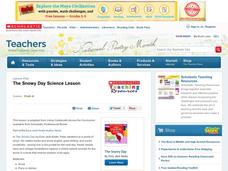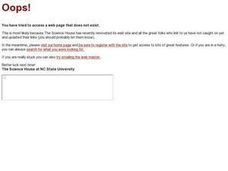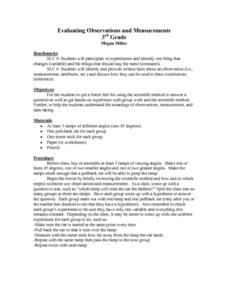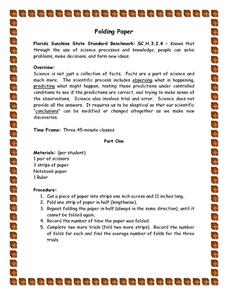Curated OER
The Snowy Day Science Lesson
Students listen to the story The Snowy Day by Ezra Jack Keats in order to become interested in the world of snow. In this snow exploration instructional activity, students scoop up snow to make snowballs, measuring the amount of snow...
Curated OER
Observation Journal
In this ocean life worksheet, students observe the plants, animals, human activity, park rules/local laws, at a specific location. Students also observe any activity in neighborhoods, the water sources for the area, the water uses, and...
Curated OER
Lab Report Template
In this biology worksheet, students complete a lab report being as detailed as possible. They identify the problem or hypothesis. Then they write the procedures and record their findings. Students also analyze their results, discuss, and...
Curated OER
Leaf Observations
Second graders examine a variety of leaves. In groups or individually, they write down their observations on each leaf type and compare them to each other. To end the lesson, they share their observations with the class and draw the...
Curated OER
Wonderful Waves
Students read about water, waves and the sea. They experiment with the action of water by pouring water into baking pans and watching how it moves. They build and examine a 'wave bottle' by adding colored water and vegetable oil to a...
Curated OER
Gathering Weather Information
Students watch a video of a recent weather disaster. Using the internet, they work together to examine the weather forecast for tomorrow and next week and discuss why it is important to know the weather. In groups, they use weather...
Curated OER
Fossils
First graders write a brief informational description of a real life object, person, place or event using information gained from observations. They create their own fossil imprints and write a brief description about the fossil that...
Curated OER
Graphing Sound
Students formulate an understanding of sound as a vibration and draw their graph as carefully as possible on their observation sheet. They also record how they made the sound and and a description of the sound. Finally, students cut out...
Curated OER
Scientific Method for Middle Schools
Learners use the scientific method to solve a teacher scenario. They bring in M&M's. Students are given a copy of the scientific method. They first come up with a problem. Learners are told that they are going to conduct an...
Curated OER
Fossil Evidence
Young scholars evaluate each other's fossil imprints and they try to identify the original object. They comprehend the importance of accuracy in identifying a fossil imprint. Students create an answer sheet that has space for the names...
Curated OER
Birds and Birdfeed
Fourth graders examine the basic survival needs of birds before examining a suet ball as an example of what birds eat. They conduct an experiment with pine cones, bird seed, vaseline, and peanut butter. By observing the birds, they...
Curated OER
Evaluating Observations and Measurements
Third graders review the scientific method and how and in which steps scientists use observations and measurements. Then as a class, they hypothesize which ramp will send the car the farthest. They break into groups and send cars down a...
Curated OER
Building a Bridge
Students build a bridge out of an index card that support the largest amount of mass. They create their bridge using an index card and books. Students place weight on the index card. They observe what happens as more weight is added to...
Curated OER
Sunlight and Heat
Students brainstorm about the sources of heat. They discuss that sunlight is one of those sources. Students complete a lab about cold water and warm water. They record the temperatures from each thermometer and discuss which container...
Curated OER
Folding Paper
Young scholars use the scientific process and their knowledge to obeserve, predict, and test their predictions under controlled conditions to verify their predictions and then make sense of these predictions. They also graph, write...
Curated OER
Shapes, Shapes Everywhere!
Sixth graders investigate the geometric concept of shapes. They locate shapes in their immediate environment and label them according to basic shape. The shapes that are found are recorded by the teacher on chart paper and any...
Curated OER
Snails
First graders investigate the organism known as a snail. They use snails to make observations of the body structure and the basic needs. The class is shown a chart and the teacher uses questions to induce student thinking. Then they...
Curated OER
Farm Animal Friends
Students apply basic communication and math skills to situations. They apply prior knowledge to list characteristics of different animals. They listen to music to engage multiple senses. Then images of animals are shared with them to...
Curated OER
Time-Lapsed Observations
Students explore timed observations for science investigations. They record ideas on a chart related to a classroom closed terrarium. They repeat their observations for several days and time observations for changing shadows during the...
Curated OER
3-Dimensional People
Learners collect objects that represent themselves. In a class discussion, they consider how they are seen and understood by others. Students create two sculptures, one of how others see them and another of how they see themselves.
Curated OER
Rock Art
Pupils create replica symbols of rock are found in Wisconsin and work cooperatively to create a rock art panel. They observe rock art to find their meanings and reasons why they were created.
Curated OER
Investigating Animals in Water
Students observe small animal activity. They identify local water animals and describe the habitats where water animals can be found. Students collect samples to observe in the classroom.
Curated OER
The Sum of the Parts
Second graders observe some everyday common objects in order to attempt to learn about simple systems and how they fit together. They observe small details in order to identify the parts of a whole design.
Curated OER
The Gummy Worm Lab
Students participate in a lab experiment with gummy worms. In groups, they record the qualitative and quantitative observations during the lab. They use their senses to make inferences about the experiment and share them with the class.

























